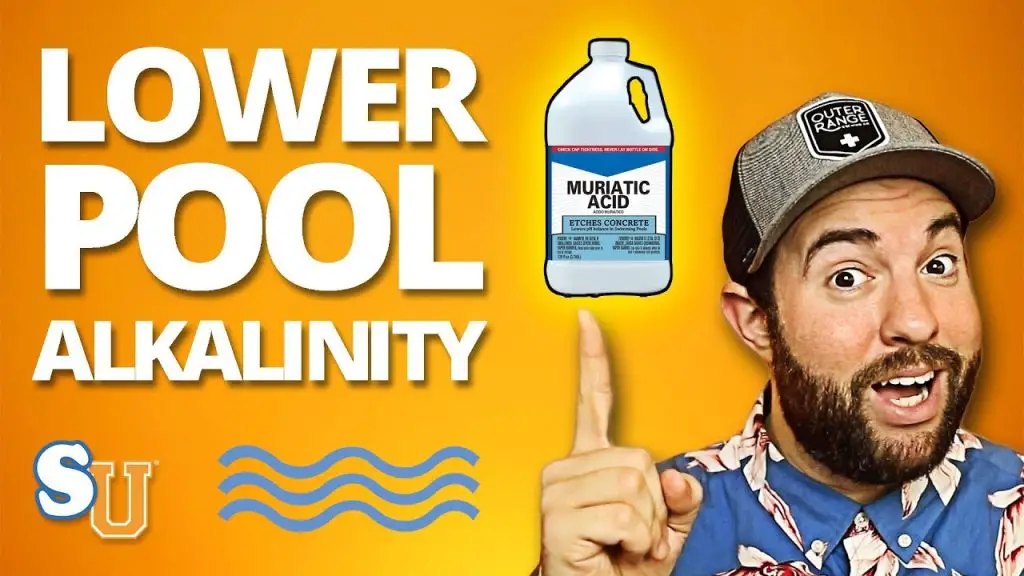To lower the alkalinity in a pool, you can add muriatic acid or sodium bisulfate. Maintaining the proper alkalinity level in your pool is essential for balanced water chemistry and ensuring a comfortable swimming experience.
However, if the alkalinity level becomes too high, it can lead to cloudy water, scaling, and difficulty adjusting other chemical levels. We will discuss simple techniques on how to lower alkalinity in a pool. By following these steps and taking the necessary precautions, you can effectively reduce the alkalinity level and maintain a clean and inviting pool for everyone to enjoy.

Credit: m.youtube.com
Testing Alkalinity
When it comes to maintaining a pool, one of the key parameters to monitor is alkalinity. Testing the alkalinity of your pool water is essential to ensure that the water remains balanced and safe for swimming. Regular testing allows you to take the necessary steps to lower alkalinity levels, preventing issues such as scale formation and pH fluctuations.
Using Test Strips Or Liquid Test Kits
There are several methods to test the alkalinity of your pool water, with two popular options being test strips and liquid test kits.
- Test Strips: Dip the test strip into the pool water and compare the color change to the provided chart to determine alkalinity levels.
- Liquid Test Kits: Follow the instructions to add the provided reagents to a water sample, and observe the color change to determine alkalinity levels.
Interpreting Test Results
Once you have conducted the test, it’s important to understand the results to take appropriate action. Here’s how to interpret test results using both test strips and liquid test kits:
| Test Results | Action |
|---|---|
| Low Alkalinity (Below 80 ppm) | Add an alkalinity increaser to raise levels. |
| High Alkalinity (Above 120 ppm) | Add a pH reducer to lower levels. |
| Optimal Alkalinity (80-120 ppm) | No action required; the levels are balanced. |

Credit: waterguru.com
Adjusting Alkalinity Levels
Adjusting the alkalinity levels in your pool is crucial to maintaining balanced water chemistry and preventing issues such as scale formation and pH fluctuations. High alkalinity levels can lead to cloudy water and make it difficult to maintain the proper pH level, while low alkalinity can cause corrosion of metal fixtures and surfaces.
Using Muriatic Acid
To lower alkalinity in your pool, you can use muriatic acid. Before adding the acid, ensure the pool’s pH level is in the ideal range of 7.2-7.8. The amount of acid needed depends on your pool’s alkalinity level, so it’s essential to follow the manufacturer’s instructions and use a pH and alkalinity testing kit to determine the correct dosage.
Adding Sodium Bisulfate
Another method to lower alkalinity is by adding sodium bisulfate, also known as dry acid. This substance works similarly to muriatic acid but is safer to handle. Again, it’s crucial to perform a water test to determine the correct amount needed based on your pool’s current alkalinity level.
Increasing Alkalinity
Lowering alkalinity in a pool is crucial for maintaining water balance. By using muriatic acid or pH decreaser, you can effectively decrease alkalinity levels. Regular testing and adjustment will help prevent pH fluctuations and keep your pool water crystal clear.
Increasing Alkalinity in your pool is crucial for maintaining water balance and clarity.Adding Baking Soda
Adding baking soda is a simple way to raise alkalinity levels in your pool. – Measure the current alkalinity level using a test kit. – Calculate the required amount of baking soda. – Dissolve baking soda in a bucket of water. – Pour the solution into the pool evenly.Using Alkalinity Increaser
Using an alkalinity increaser is an effective way to quickly adjust alkalinity levels. 1. Measure the pool’s pH and alkalinity levels. 2. Follow the manufacturer’s instructions on the product packaging. 3. Add the alkalinity increaser to the pool water. 4. Allow the water to circulate for a few hours. Maintaining proper alkalinity in your pool ensures a safe and enjoyable swimming experience. Regular testing and adjustment are key to a balanced pool environment.Preventive Measures
Prevention is key when it comes to maintaining a healthy pool environment. By implementing a regular maintenance schedule and ensuring properly balanced chemicals, you can effectively lower alkalinity in your pool. Let’s dive into these preventive measures in more detail:
Regular Maintenance Schedule
A consistent maintenance schedule is essential to keeping your pool water in optimal condition. Here’s a breakdown of the key tasks that should be included in your regular maintenance routine:
- Skim the surface of the pool water daily using a net to remove any debris or leaves.
- Vacuum the pool floor and walls weekly to eliminate any dirt or algae buildup.
- Brush the pool walls and steps regularly to prevent the growth of algae or other contaminants.
- Check and clean the pool filter system at least once a month to ensure proper functioning.
- Monitor the pool water level to prevent it from getting too low or too high. Adjust as necessary.
- Test the pool water regularly using a reliable water testing kit to maintain the desired chemical levels.
Properly Balanced Chemicals
The proper balance of chemicals is crucial for maintaining the alkalinity level in your pool. Here’s what you need to remember:
- Chlorine: Maintain an appropriate chlorine level between 1 and 3 ppm to prevent the growth of bacteria.
- pH Level: Keep the pH level between 7.2 and 7.8 to ensure the effectiveness of your chlorine and other chemicals.
- Alkalinity: Lower alkalinity can be achieved by adding muriatic acid or sodium bisulfate to your pool water as per the manufacturer’s instructions.
- Cyanuric Acid: Regularly test and maintain cyanuric acid levels between 30 and 50 ppm to protect chlorine from being broken down by sunlight.
Remember, a well-maintained pool with properly balanced chemicals not only helps to lower alkalinity but also provides a safe and enjoyable swimming experience for everyone.
Professional Help
In some cases, lowering the alkalinity in your pool may require professional help. Here are some scenarios and guidelines for when it may be necessary to seek the expertise of pool professionals.
Seeking Advice From Pool Experts
If you are facing difficulty in managing the alkalinity levels in your pool or suspect that there may be an underlying issue causing the imbalance, it may be best to consult with experienced pool specialists. They can offer valuable insights and recommendations tailored to your specific situation.
When To Call In A Pool Service
It’s advisable to consider hiring a pool service if your attempts to lower the alkalinity have been unsuccessful or if you lack the time and resources to address the problem effectively. Professional pool technicians have the necessary tools and expertise to accurately diagnose the issue and implement the appropriate corrective measures.
Common Mistakes To Avoid
Common Mistakes to AvoidWhen working to lower the alkalinity in your pool, it’s essential to avoid common mistakes that can hinder the process. By being mindful of these errors, you can ensure the effectiveness of your efforts and maintain a balanced pool environment. Here are the key mistakes to steer clear of:
H3 Overdosing ChemicalsOverdosing Chemicals
Overdosing pool chemicals can lead to imbalances that make it more challenging to lower alkalinity. Excessive use of pH or alkalinity decreaser can cause a rapid drop in levels, which may result in further imbalances and prolong the correction process.
H3 Ignoring Alkalinity LevelsIgnoring Alkalinity Levels
Neglecting to monitor the alkalinity levels regularly can lead to unexpected spikes, making it harder to adjust. Without proper monitoring, it becomes difficult to keep the alkalinity within the recommended range, potentially leading to more severe issues down the line.

Credit: waterguru.com
Conclusion
Lowering alkalinity in your pool is crucial for maintaining a balanced and healthy swimming environment. By following the tips and methods discussed in this blog post, you can effectively reduce alkalinity levels. Remember, regular testing and maintenance are key to enjoying a sparkling and well-maintained pool all season long.





